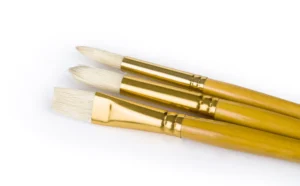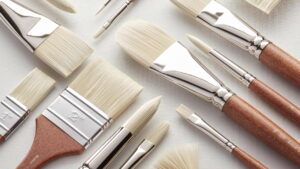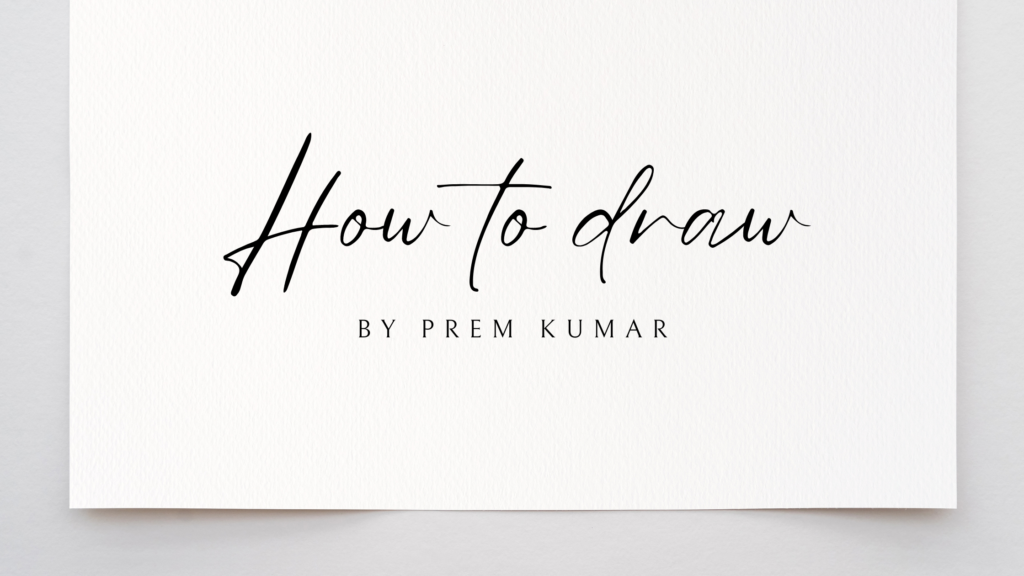Brush Bristles: Your Key Artistic Tool The choice of brush in your creative toolkit is pivotal, wielding a substantial influence on your artwork. A crucial decision revolves around opting for brushes with natural or synthetic bristles. Each variety boasts unique qualities, advantages, and drawbacks, making it essential to comprehend these distinctions for informed decisions in your artistic pursuits
Natural Brush Bristles: An Age-Old Tradition

For millennia, painters have relied on natural bristle brushes. These brushes, which are typically constructed from animal hair such as hog, sable, or mongoose, provide a number of benefits that have survived the test of time.
1. Texture and Absorbency: Natural bristles have a gritty texture that effectively holds and releases paint. This property comes in handy when working with thicker paints, like oils and acrylics. Natural bristles’ absorbency allows them to retain more paint, resulting in longer brushstrokes without repeated reloading.
2. Durability: Natural bristle brushes are typically sturdier and more durable than synthetic bristle brushes. They can survive the rough texture of some canvases and keep their shape over time, allowing artists to be consistent in their strokes.
3. Versatility: Natural bristle brushes perform admirably in a wide range of artistic applications, from broad strokes to precise detailing. They are especially well-suited for oil painting, where the roughness and thickness of the paint require the use of a strong brush.
4. Natural Flow: The natural flow of a natural bristle brush is generally appreciated by artists. The way these brushes release paint can help to achieve the spontaneous, organic feel that many painters strive for in their work.
Synthetic Brush Bristles: Ethical Considerations Meet Innovation

Synthetic bristle brushes have grown in popularity in recent years, providing an alternative for artists who are environmentally conscious or looking for specific properties in their brushes.
1. Vegan and cruelty-free: One of the major advantages of synthetic brushes is that they are vegan and cruelty-free. Artists who are concerned about the ethical concerns of using animal hair can use synthetic bristle brushes instead.
2. Consistency and Precision: Synthetic bristles have a uniform texture and shape. They do not have the natural inconsistencies that can come with animal hair, as do natural bristle brushes. Because of their consistency, synthetic brushes are great for intricate work and exact lines.
3. Water-Based Medium Versatility: While natural bristle brushes may struggle with a water-based medium such as watercolors, synthetic brushes thrive in this area. They keep their shape and do not absorb water, giving you more control and precision when working with watercolors and acrylics.
4. Allergen-Free: Because some artists may be allergic to animal hair, synthetic brushes are a good option for those who want to prevent potential sensitivities.
Making the Best Decision for Your Art
Consider the specific needs of your artistic practice as well as your personal preferences when choosing between natural and synthetic bristle brushes.
1. Medium is Important: The type of paint you use is important. Natural bristle brushes may be ideal if you typically work with oils due to their texture and absorbency. If you prefer watercolors or acrylics, synthetic brushes may provide superior control and precision.
2. Ethical Considerations: If you are concerned about animal welfare, synthetic brushes offer a cruelty-free alternative without sacrificing quality.
3. Budget and maintenance: Natural bristle brushes are frequently more expensive than synthetic bristle brushes. Furthermore, natural brushes may require more attention to preserve their form and lifespan. Consider your finances as well as your willingness to devote time to brush care.
4. Trial and Error: Hands-on experience is the best approach to deciding your preference. Experiment with both natural and synthetic brushes to learn how they feel in your hand and how they function on your chosen canvas.
Conclusion
The decision between natural and synthetic bristle brushes comes down to your creative choices, ethical considerations, and the precise requirements of your chosen medium. Whether you choose the time-honored heritage of natural bristles or embrace the revolutionary capabilities of synthetic brushes, recognizing the differences between the two will definitely improve your artistic practice.
Also Read: A Comprehensive Guide to Brush Selection
To learn more about art, visit SILPAVAT.IN


